
Hello everyone! Happy New Year even though it’s mid-January already! 😊
I hope you all had a wonderful holiday time! I sure did! We spent Christmas in NYC and it was so pretty! It was a great trip, we disconnected from the routine and eat some delicious food! (I’m looking at you, Queens Chinatown!). We walked, walked, walked… My fitbit was so happy!
Unfortunately, the holidays are over, and we have a new chance to start living a healthier life. Less sugar, more veggies, more FIBER.
For those who don’t know, I do research on high fiber bread, so I know a bit about the importance of eating fiber and I know how difficult it is sometimes to eat the 25g/day that the FDA recommends.
This is what 25g of fiber looks like:
- 1.2 kg of boiled kale OR
- 240 g of old fashioned oats OR
- 2.7 Kg of grapes OR
- 1 kg of broccoli
It’s very possible you’re not eating enough fiber. But what if you change your bread slices for whole grain bread? Bread is an excellent way to increase our fiber intake because it’s everywhere! Morning toasts, lunch sandwiches, dinner rolls, garlic bread, snack crackers… you name it!
Easy, right?
NOPE
If you’ve baked a few loaves, you might now already how difficult it is to bake with whole wheat flour, and more so if you want to add more grains or a mixture of flour with less (or none) gluten.
I could literally go on a full essay on why this happens (currently writing my dissertation, it’d be a copy/paste lol), but long story short: THE GLUTEN NETWORK.
A little bit of nerdy talk.
What happens when there’s fiber in the bread dough?
We all know that gluten is what makes the dough elastic, what helps the dough retain the gas the yeast releases and what helps the baked bread have that particular structure and soft crumb. When we add fiber (as cereal bran, whole grains etc.) there are three major things that happen in the bread:
1.-The replacement some of the flour with some cereal bran, grains etc. that DON’T have gluten, so for the same weight of bread,
2.- Competition for water between gluten proteins and fiber. Gluten proteins need water to bind to each other and create the gluten network. Without enough water, the network can’t be developed properly, and it’d be weaker. BUT fiber loves water too and can take it faster than the gluten proteins, so they cannot build a good gluten network.
3.- We’re still not sure about how it works, but some molecules present in the cereal bran might interact with the gluten proteins and weaken the gluten structure, making the dough more prone to collapse during fermentation and/or baking.
Basically, everything that makes bread healthier, destroys its structure (and texture, and quality).
OH, THE IRONY!
With this recipe, I had to face another problem: whole rye flour. Rye flour has a different type of gluten and it works a bit different. It’s going to affect the dough and the final bread.
Lucky for us, we can add a bit of magic to our dough, that is: vital wheat gluten.
For those who are not sure about adding “weird” things to your bread I’ll say this: Unless you have a gluten allergy or sensitivity, adding extra gluten to your bread it’s perfectly safe. If you do have a problem with it, you probably wouldn’t be eating bread anyway.
You can make this recipe without the extra gluten, but the dough will be less elastic and the bread will have a denser crumb. I’ve tried with and without and the difference is palpable!
Why is fiber so healthy?
We all know fiber is good, but why?
You know fiber helps us… ehm… to go to the toilet more regularly! And this is important because that’s the way our body has to get rid of toxins and sometimes even cells that are acting weird and could become cancerous. Fiber also helps us regulate the bad cholesterol, it makes us feel full for
FIBER FEEDS THE GUT MICROBIOTA! Fiber is super important to keep your gut bacteria healthy and balanced. And gut bacteria is EVERYTHING! Everyday there are new studies that link our gut bacteria to something unexpected like mental health or neurodegenerative diseases. It’s an amazing field of research by itself.
Seriously, I cannot stress enough how important fiber is for the proper functioning of our body. So please, please, please… today more than ever: eat your veggies!
Now, this doesn’t mean that eating all the veggies and all the fiber is going to fix all our problems. But it will significantly reduce the probability of developing other problems or suffering other diseases, and help you have a healthier lifestyle 😉
This bread is also vegan, so if you’re lactose-free, egg-free, vegan or taking part in Veganuary this is your bread!
Without further ado, here are my notes on the recipe!
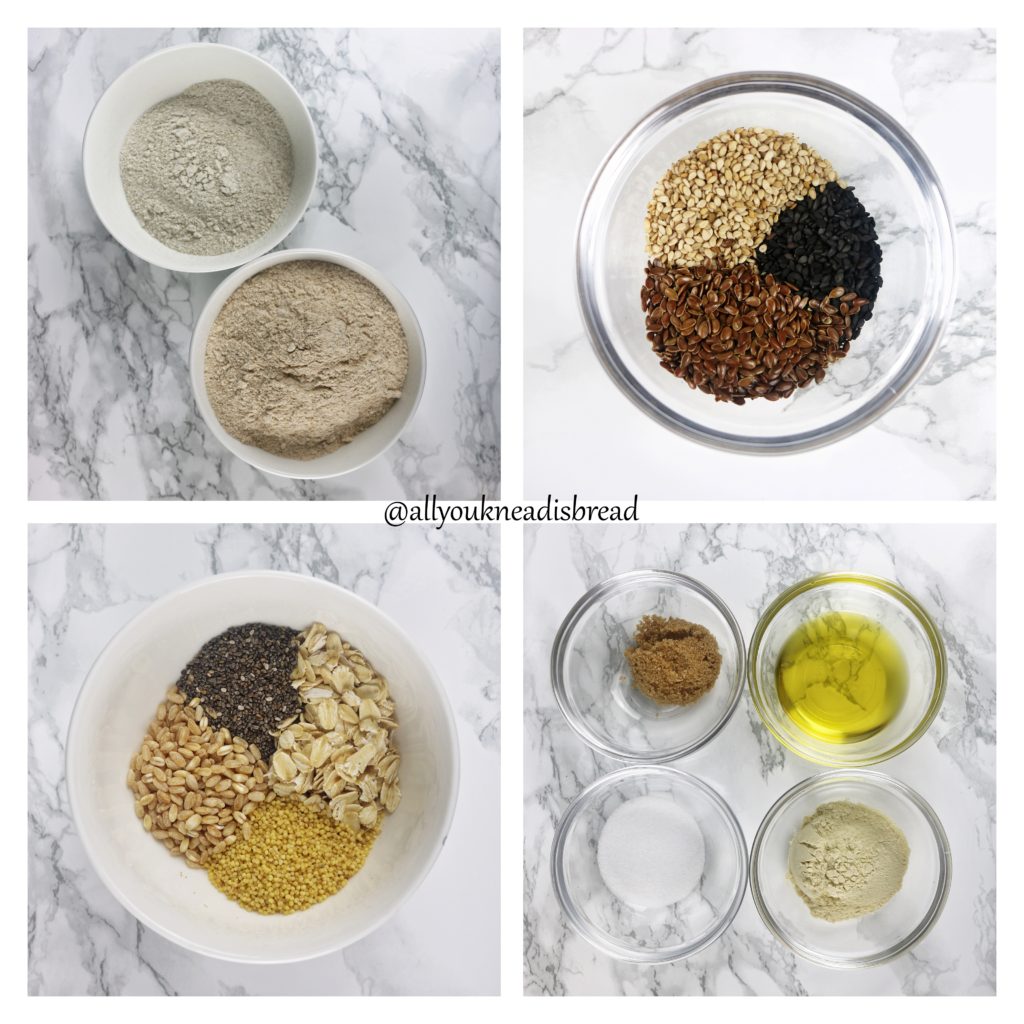
The very first thing to do is to soak the grains that would take up lots of water. Oats, chia seeds, wheat grains and millet in my case. But feel free to add whatever you want!
Boil some water and add it to where you have your grains. Don’t worry about the amount, just make sure there’s plenty. You’ll rinse the water later on.
Let the grains soak until the water is at room temperature or lukewarm. In the meanwhile, you can prepare the rest of the ingredients.
Mix all the flours, the salt and the vital wheat gluten ( I like to add the salt now because this dough is a bit reluctant to absorb it later on. But you can perfectly add the salt later if you prefer).
Take 300 g of water and dissolve the sugar and the yeast in it. Start with just 300g you’ll add more water with the grains that are soaking and your flour might not have as much protein as mine, so start with 300 and add more gradually if needed.
Once the temperature of the soaking grains is okay, use a colander and get rid of as much water as you can. It should be viscous and the grains should be swollen
To the yeast mixture add the soaked grains and mix well.

Then add the sesame and flax seeds.

Add the wet ingredients to the flour mixture and mix until you don’t see wet particles. If the dough doesn’t come together add more water, 1 tbsp at a time. I used 350 g of water.
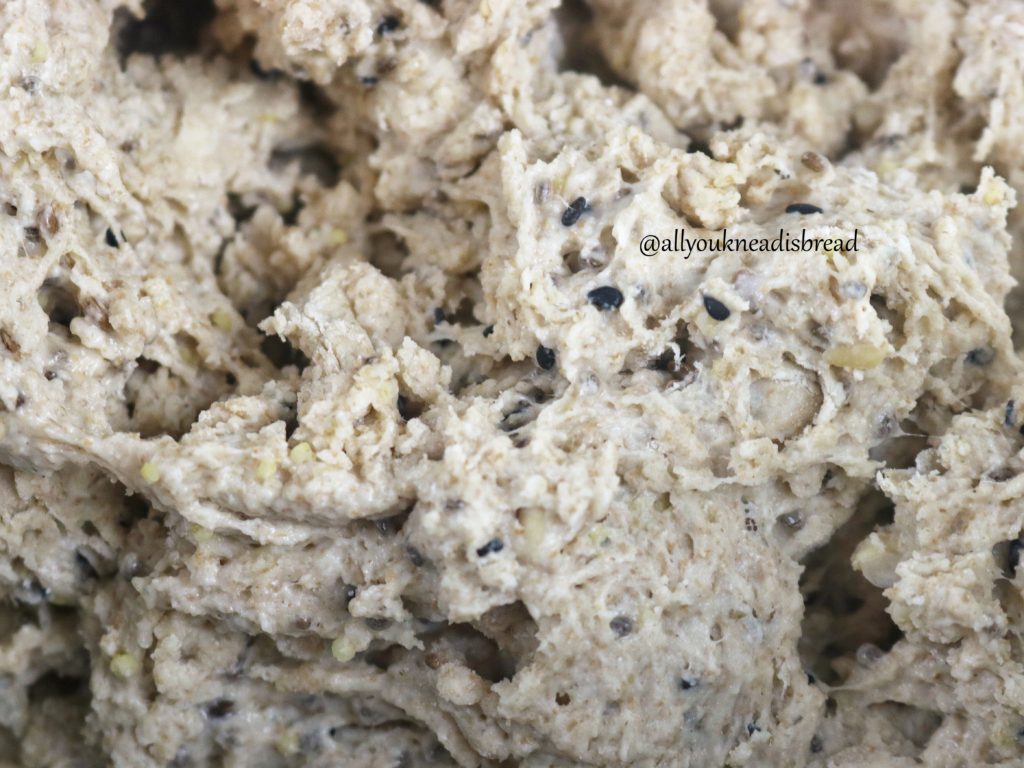
Let the dough rest for 25mins to make sure the water can be absorbed by the flour particles.
After the autolysis period, start kneading the dough and when it starts getting a bit of consistency, add the oil little by little and knead until the dough is no longer sticky and has a good elasticity.
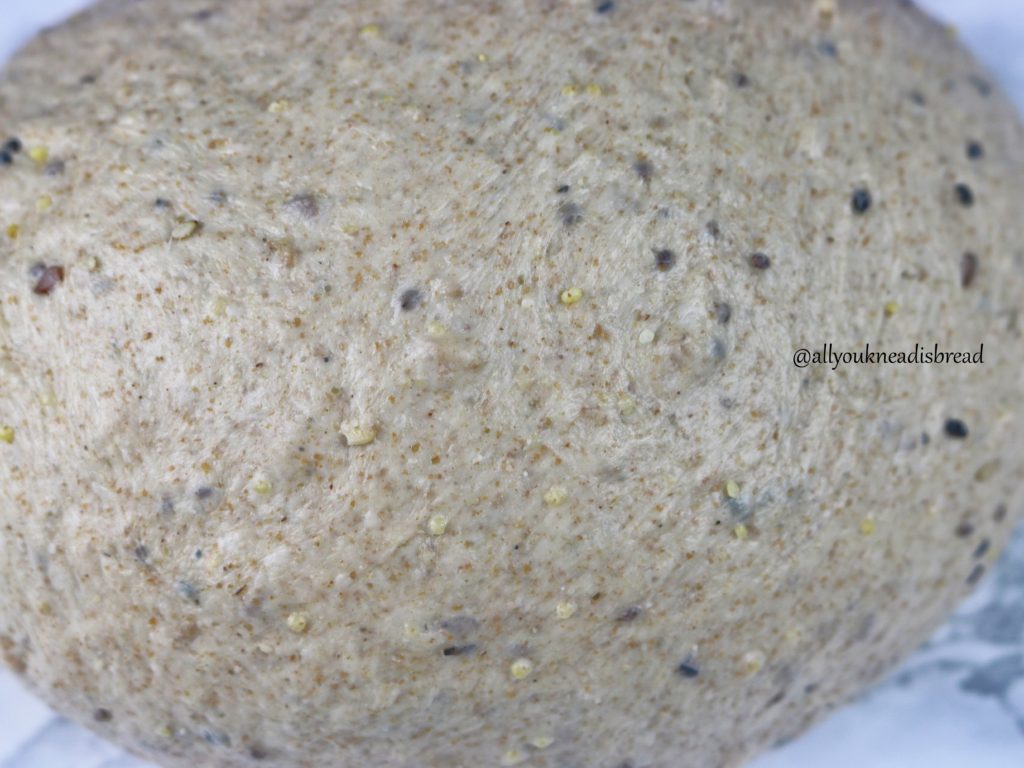
You can replace the oil with whatever other fat of your choice. I like to use olive oil because it’s a good source of omega 3 and I love the taste . Plus, I wanted to make this bread vegan because I am doing veganuary! 😊
I love this dough! The extra gluten works wonders. You’ll see how great it is to knead!
When the dough is ready, place it in a lightly oiled container and let it ferment until it doubles in size. This recipe yields 2 loaves.

Deflate the dough and separate it into two equal balls and let them rest, covered, for 5 minutes
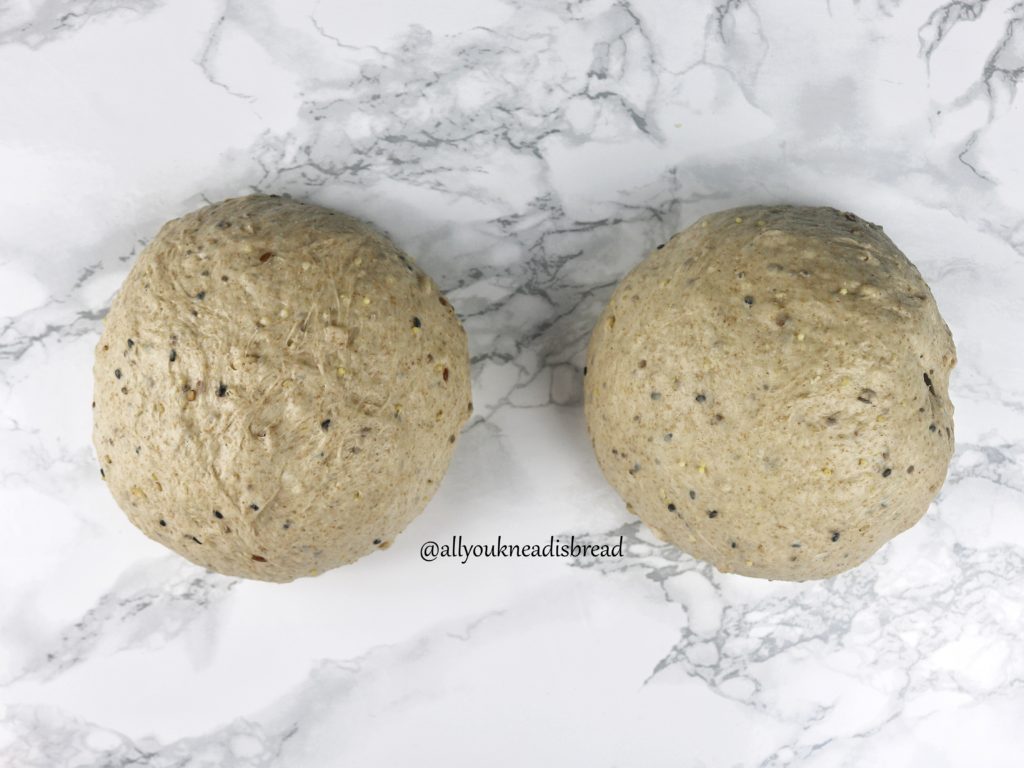
Shape the dough and use either a metallic mold or a banneton. I used bannetons because I wanted a “rustic” loaf.
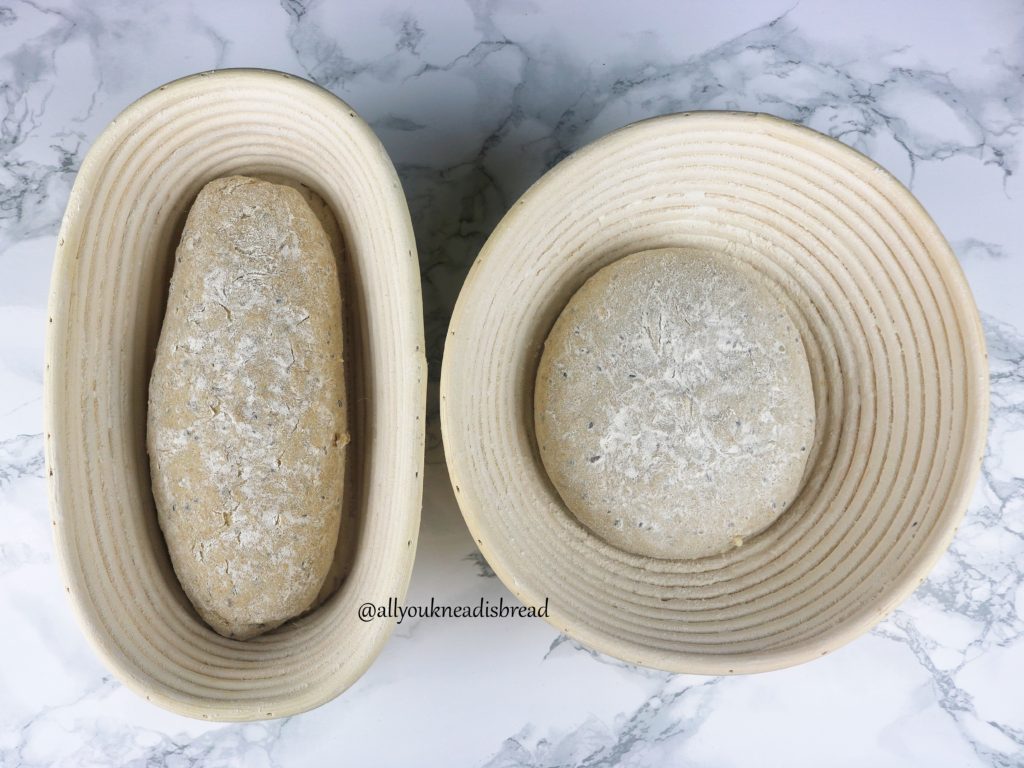
Let the dough rise until is puffy. Follow the “poke” test to know how your dough is.
Turn on your oven at 450F. If you’re using a pizza stone or a dutch oven let them heat up inside of the oven.
Before placing the dough in the oven score it (Make a deep cut), you can even practice a bit your scoring skills, this is a very nice dough to do so because it’s easy to cut through.
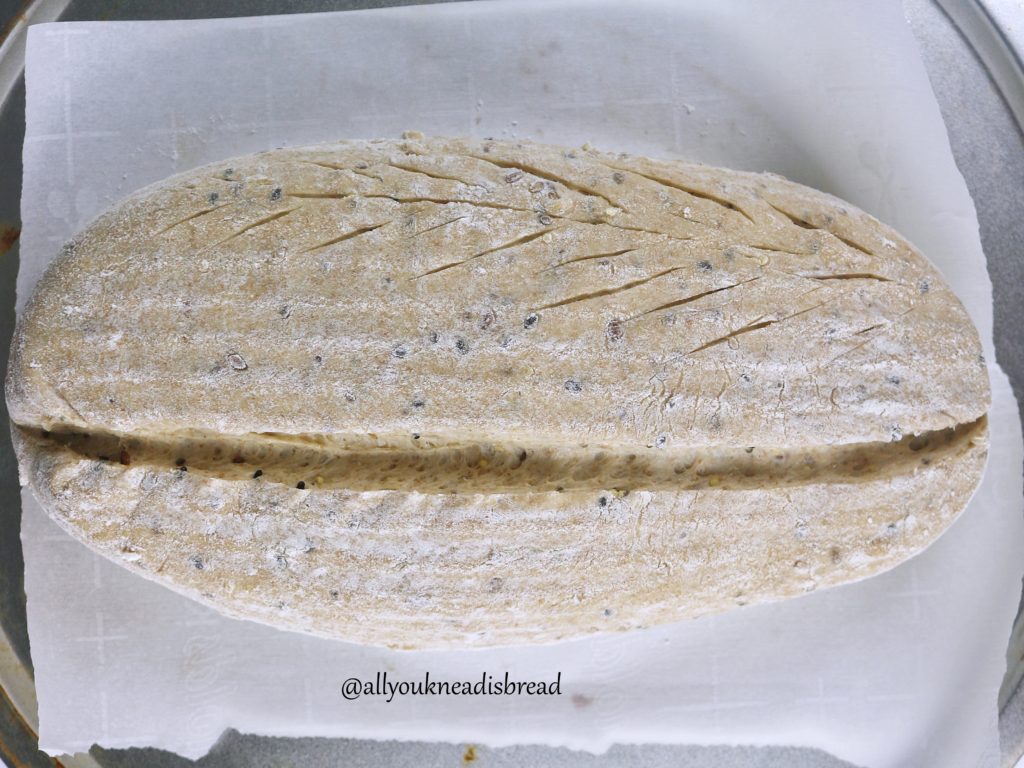
Put the bread in the oven and let the magic happen!
If you’re using a pizza stone, make sure you generate enough steam inside to allow a proper oven rise. If you use a dutch oven, you can spray a bit of water on the dough or even put a little piece of ice inside.
If you’re using a dutch oven, take the lid off after 25mins of baking and keep baking until it gets a nice brown color.
Take the bread out of the oven and let it cool down. Right after baking the bread might feel a bit hard, but the crust will soften. This bread is perfect for sandwiches!


Fiber packed loaf
Ingredients
- 140 g whole wheat flour
- 60 g whole rye flour
- 360 g bread flour
- 17 g vital wheat gluten
- 20 g extra virgin olive oil
- 14 g brown sugar
- 10 g salt
- 1/2 cup mixed grains (millet, oats, wheat, chia seeds)
- 2 tbsp white sesame seeds
- 2 tbsp black sesame seeds
- 2 tbsp flax seeds
- 7 g active dry yeast
- 300-350 g water
Instructions
-
Soak the grains with boiling water and let them rest until they cool down to room temperature.
-
Mix the whole wheat flour, bread flour, rye flour, vital wheat gluten, and salt.
-
Dissolve the yeast and the sugar in 300 g of water and let it rest for 5 minutes to activate the yeast.
-
When the soaking grains are at room temperature use a strainer or colander to drain the water and add them to the yeast mixture.
-
Add the seeds to the yeast and grains mixture and mix thoroughly.
-
Add the wet ingredients to the dry ingredients and mix with your hand until you don’t see dry flour particles. Adjust water if needed 1 tbsp at a time.
-
Cover the dough and let it rest for 25 minutes.
-
Start kneading the dough and when it starts to be elastic add the oil little by little.
-
Keep kneading until the dough is no longer sticky and it’s very elastic.
-
Place the dough in a lightly oiled container and let it ferment, covered, until it doubles in size (about 2h in a cold kitchen – approx time).
-
Deflate the dough and separate it into 2 equal parts.
-
Roll each part into a ball, cover them and let them rest for 5 minutes.
-
Shape each loaf and place it in a floured banneton or a couche or a lightly oiled Pullman pan.
-
Let the loaves ferment until they’re puffy (about 1h in my kitchen). They don’t have to necessarily double in size.
-
Preheat your oven at 450 F with the pizza stone or dutch oven inside if you’re using any of those.
-
When the loaves are ready, take them out of the bannetons, score them (avoid scoring if you’re using a Pullman pan), and put them inside of the dutch oven or on top of the pizza stone.
-
Bake for 25 minutes and remove the lid of the dutch oven if using it. If no, bake for 45 minutes or until the loaves have a nice brown color.
Enjoy!

